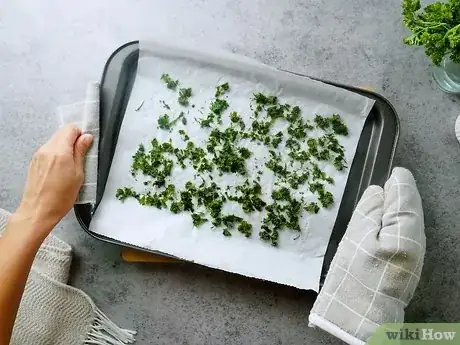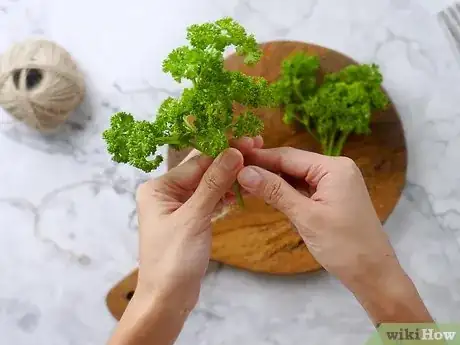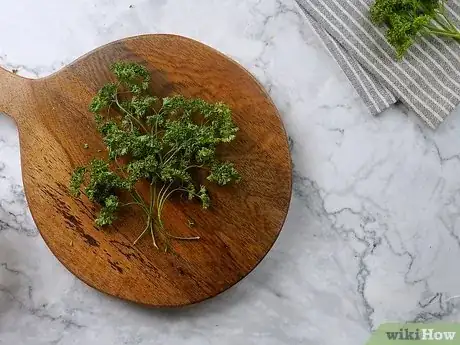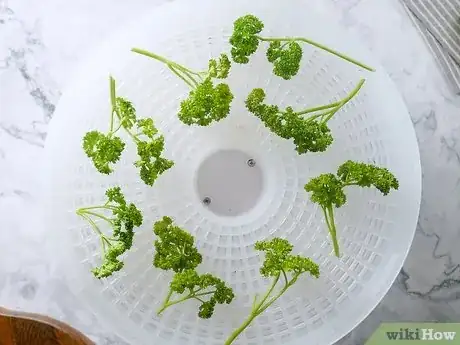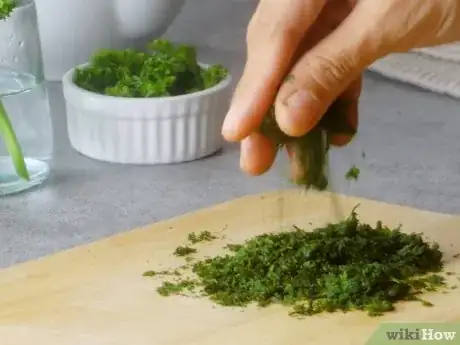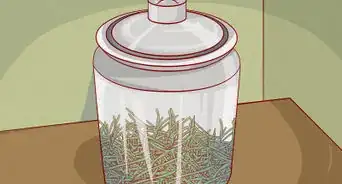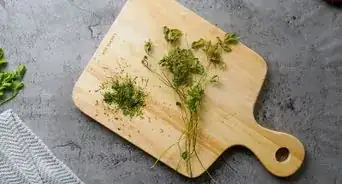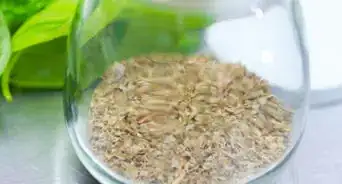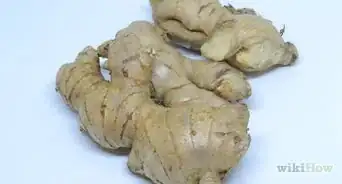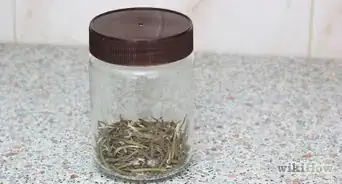wikiHow is a “wiki,” similar to Wikipedia, which means that many of our articles are co-written by multiple authors. To create this article, 10 people, some anonymous, worked to edit and improve it over time.
The wikiHow Culinary Team also followed the article's instructions and verified that they work.
This article has been viewed 387,420 times.
Learn more...
Parsley can be used to spruce up many dishes and will keep for up to a year if properly dried and stored. If you've got a whole bunch of fresh parsley you don't know what to do with, keep reading to learn how to dry it and make it last.
Steps
Drying Parsley in the Oven
-
1Wash fresh parsley in cold water. Pick out the woody bits of stem and separate the tender leaves and chop the parsley into 1/4" pieces. Then, blanch the parsley in boiling water for 20 to 30 seconds.
-
2Place brown paper across a baking sheet. Arrange the blanched parsley across the tray. Try to keep it flat and evenly spaced, with no big clumps of parsley sticking together.[1]Advertisement
-
3Place in the oven. Turn the oven on to the lowest possible setting. The best time to do this method is after the oven has been turned off, following other baking. Otherwise, always err on the side of taking longer than having it too warm and burning the parsley.[2]
-
4Dry the parsley for 2-4 hours. The exact time will vary based on the relative humidity in your area and the altitude. Keep an eye on it, because it might dry more quickly. It's ready when it crumbles easily in your fingers.[3]
-
5Remove from the oven. Crush the parsley with your hands or in a mortar and pestle. Remove any remaining stalks.[4]
-
6Place the crushed, dried parsley into a storage container. Store in a dry, dark place, or even the freezer. Parsley dried this way can be good for long periods of time, but will start to lose its flavor after several months.
Air-Drying Parsley
-
1Pick the parsley in the morning. If you're going to air dry parsley, you want to make sure you gather it at its most tender point, which is early in the morning, but enough after sun-up to have burned off the dew from the night before.
- Don't worry about washing the parsley if you've picked it. It should be as dry as possible to start out with.
-
2Gather the parsley in bundles. Keep them fairly loose so that air can circulate around the leaves as they dry. You can make bundles as big as your hand or you can keep the bundles smaller if you wish. Just make sure they're not too tight when you tie them.
-
3Secure the bundles with twine or rubber bands. Rubber bands are easiest if you have bigger bundles. Secure the stems of the parsley, letting the larger, leafier portion fan out while it dries.
-
4Place the bundles in brown paper bags. Storing the drying bundles in bags will keep them dust free and won't allow sunlight to bleach the color from the parsley. Cut some holes in the bags to allow air to circulate, and keep the bundles nice and dry.
- Store the bags in a cool, dry place with good air circulation. Stacking them on a drying rack, or an old clothes rack can be a good method of storing them.
- Alternatively, you can leave them out of the bags and tie them with string to hang in your kitchen and dry. Hang the bundles upside down for a more decorative, but equally effective, method of drying.
-
5Remove the bundles after two weeks. The parsley is dried when it becomes easily crumbled in your fingers. Spread the bundles on the counter on a piece of wax paper or a cutting board, and crumble the bunches, taking care to remove the woody stems.
-
6Store the parsley in an airtight container. Save old herb containers to reuse for your dried parsley, keep them in mason jars, or other containers. Store in a cool dry place in your kitchen.
Dehydrating Parsley
-
1Consider using a food dehydrator. While they can be pricey, dehydrators can offer lower heat and more drying control than the oven. If you want to be able to dry parsley quickly, this can be an effective method.[5]
- Usually, food dehydrators will have an herb setting. Clean the parsley as you would to dry it in the oven, spread the parsley on the drying trays, and follow the instructions on your dehydrator.
-
2Use the power of the sun. All you need to dehydrate parsley is a good hot day without much cloud cover and a baking sheet. You need to make sure that it isn't too humid, or the parsley won't dry properly.[6]
- Old window screens can make excellent drying racks to separate the parsley from the cookie sheet or baking tray. Cut the old screens to fit the size of the tray, and place the parsley on top to keep air flowing evenly around the parsley as it dries in the sun.[7]
- Over the course of the day, turn the parsley over so it gets evenly tanned on both sides. Depending on where you live and the amount of sun available, it may take a few days or be perfectly dry by lunchtime. Keep an eye on it and make sure to bring it in when it gets dark, to avoid dew.
-
3Use the microwave. You can dry parsley in the microwave, but you can also burn it very quickly, and its difficult to get the parsley dried evenly (as with most microwaved things). If you want to use the microwave, spread your cleaned parsley out on a paper plate in a single layer and nuke it for a minute or two at a time. Keep close watch. If it starts getting dark, or smoking, take it out.[8]
-
4Finished.
Community Q&A
-
QuestionI used the second method to dry my parsley, but it turned yellow. What could be the issue?
 Community AnswerMaybe the parsley was spoiled, or perhaps the weather adversely affected it.
Community AnswerMaybe the parsley was spoiled, or perhaps the weather adversely affected it. -
QuestionCan parsley cause miscarriages?
 Community AnswerNo, parsley will not cause a miscarriage.
Community AnswerNo, parsley will not cause a miscarriage. -
QuestionCan drying herbs, hung to dry, absorb odors from the house and taint the flavor of the herb?
 Community AnswerI haven't observed anything like that, but I suppose it might depend on where you hang it, and whether you cook with very pungent herbs.
Community AnswerI haven't observed anything like that, but I suppose it might depend on where you hang it, and whether you cook with very pungent herbs.
Things You'll Need
- Scissors to collect parsley
- Kettle of boiling water
- Bowl for dipping
- Baking tray (sheet)
- Brown paper
- Oven mitts
References
- ↑ https://www.wifemamafoodie.com/dry-fresh-herbs-oven/
- ↑ https://www.wifemamafoodie.com/dry-fresh-herbs-oven/
- ↑ https://www.wifemamafoodie.com/dry-fresh-herbs-oven/
- ↑ https://www.wifemamafoodie.com/dry-fresh-herbs-oven/
- ↑ https://www.thepurposefulpantry.com/how-to-dehydrate-parsley/
- ↑ https://www.thekitchn.com/the-best-ways-to-preserve-parsley-221275
- ↑ http://herbs.lovetoknow.com/Drying_Parsley_Methods
- ↑ https://theviewfromgreatisland.com/how-to-dry-herbs-in-the-microwave/
About This Article
One of the quickest and easiest ways to dry parsley is in the oven. To get started, rinse some fresh parsley under cool, running water. Separate out the woody stems from the leaves and chop the washed leaves into ¼-inch (.6 cm) pieces. Next, place the chopped leaves in boiling water for 20 to 30 seconds to blanch them. This will help preserve their flavor and bright green color. Spread the blanched leaves on a baking sheet lined with parchment paper, making sure the leaves are distributed evenly. Place the leaves in the oven on the lowest possible heat setting and leave them there for 2-4 hours. Check the leaves occasionally to make sure they aren’t getting burnt or overdried. Your dried parsley is ready when it crumbles easily in your hands. Crumble it with your fingers or pound it into flakes with a mortar and pestle, then place your dried parsley in an airtight container. Keep it in a dry, dark location. If you store it properly, the parsley should stay good for several months before it begins to lose its flavor. To learn how to air dry parsley, scroll down!




